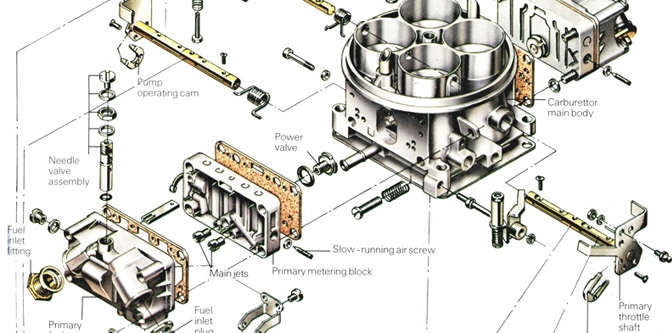The Holley 4-Barrel

Technically, the first modular Holley 4-Barrel carburetor hit the market with the 1957 Ford Thunderbird. They called it the model 4150 and it became the foundation for their 4-barrel carburetor business. And because that design has remained so consistent through the years, so has it’s short comings.
It’s a pretty typical story and one that has been told since 1957… “Man, I got this brand new Holley 4-Barrel and the damn thing keeps popping power valves, back firing, and ignoring any input I give via the mixture adjustments.” That complaint then often lead to a lot of Holley carburetors sitting on shelves after being replaced by a Carter/AFB or something similar. For street applications, the Holley just seemed to be more effort that it was worth to the layman.
Some guys figured them out though… A more prominent example of that is Barry Grant. In the mid 1980’s, he was taking stock Holley carbs, “tuning” them, and then selling them at twice the price. Before too long he was building his own carbs from scratch, getting in over his head, and declaring bankruptcy. Another story for another publication I guess, but what were the early pioneers of these 4-barrel carbs doing to get them to run consistently?
It’s more simple than you might imagine… There’s a ground breaking early custom Thunderbird going together here in Austin that you will all know of soon enough. The owner of the car has a real understanding of how a traditional car should go together and mechanically, wants the custom to be as period as it is visually. So, it was completely necessary to have an original 4150 Holley feeding the Y-block within. But this guy also drives the shit out of his cars, so it also had to run reliably.
Anyway, Keith got the call and began working over the carb this morning. According to him, the biggest flaw is simply the castings used. To demonstrate, he lightly filed one surface of the body to show the peaks and valleys of what it supposed to be a flat surface:

Stopping a little after starting and you can really see just how poorly this surface was originally prepped. Obviously, the spots with grinding marks are high spots:

And here is one plane completely finished:

Once done, Keith will move on to the other surfaces ensuring that each plane of the carb features a reasonably flat surface. Once done, he ads new gaskets and the end result is an early 4-barrel with 90% less issues than an original. I know this might be a bit elementary for some of you, but as a guy that has struggled mightily with Holleys in the past, I found it fascinating.
More on this a bit later…


